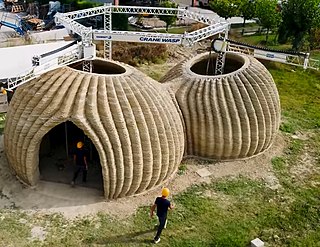
In physical geography, tundra is a type of biome where tree growth is hindered by frigid temperatures and short growing seasons. The term is a Russian word adapted from Sámi languages. There are three regions and associated types of tundra: Arctic tundra, alpine tundra, and Antarctic tundra.

Cloud feedback is a type of climate change feedback that has been difficult to quantify in contemporary climate models. It can affect the magnitude of internally generated climate variability or they can affect the magnitude of climate change resulting from external radiative forcings. Cloud representations vary among global climate models, and small changes in cloud cover have a large impact on the climate.
The carrying capacity of an environment is the maximum population size of a biological species that can be sustained by that specific environment, given the food, habitat, water, and other resources available. The carrying capacity is defined as the environment's maximal load, which in population ecology corresponds to the population equilibrium, when the number of deaths in a population equals the number of births. The effect of carrying capacity on population dynamics is modelled with a logistic function. Carrying capacity is applied to the maximum population an environment can support in ecology, agriculture and fisheries. The term carrying capacity has been applied to a few different processes in the past before finally being applied to population limits in the 1950s. The notion of carrying capacity for humans is covered by the notion of sustainable population.

Climate change affects the physical environment, ecosystems and human societies. Changes in the climate system include an overall warming trend, more extreme weather and rising sea levels. These in turn impact nature and wildlife, as well as human settlements and societies. The effects of human-caused climate change are broad and far-reaching. This is especially so if there is no significant climate action. Experts sometimes describe the projected and observed negative impacts of climate change as the climate crisis.

In biology, a refugium is a location which supports an isolated or relict population of a once more widespread species. This isolation (allopatry) can be due to climatic changes, geography, or human activities such as deforestation and overhunting.

An abrupt climate change occurs when the climate system is forced to transition at a rate that is determined by the climate system energy-balance. The transition rate is more rapid than the rate of change of the external forcing, though it may include sudden forcing events such as meteorite impacts. Abrupt climate change therefore is a variation beyond the variability of a climate. Past events include the end of the Carboniferous Rainforest Collapse, Younger Dryas, Dansgaard–Oeschger events, Heinrich events and possibly also the Paleocene–Eocene Thermal Maximum. The term is also used within the context of climate change to describe sudden climate change that is detectable over the time-scale of a human lifetime. Such a sudden climate change can be the result of feedback loops within the climate system or tipping points in the climate system.

In climate science, a tipping point is a critical threshold that, when crossed, leads to large, accelerating and often irreversible changes in the climate system. If tipping points are crossed, they are likely to have severe impacts on human society and may accelerate global warming. Tipping behavior is found across the climate system, for example in ice sheets, mountain glaciers, circulation patterns in the ocean, in ecosystems, and the atmosphere. Examples of tipping points include thawing permafrost, which will release methane, a powerful greenhouse gas, or melting ice sheets and glaciers reducing Earth's albedo, which would warm the planet faster.

There is an ongoing decline in plant biodiversity, just like there is ongoing biodiversity loss for many other life forms. One of the causes for this decline is climate change. Environmental conditions play a key role in defining the function and geographic distributions of plants, in combination with other factors, thereby modifying patterns of biodiversity.

Environmental issues are disruptions in the usual function of ecosystems. Further, these issues can be caused by humans or they can be natural. These issues are considered serious when the ecosystem cannot recover in the present situation, and catastrophic if the ecosystem is projected to certainly collapse.

Planetary boundaries are a framework to describe limits to the impacts of human activities on the Earth system. Beyond these limits, the environment may not be able to self-regulate anymore. This would mean the Earth system would leave the period of stability of the Holocene, in which human society developed. The framework is based on scientific evidence that human actions, especially those of industrialized societies since the Industrial Revolution, have become the main driver of global environmental change. According to the framework, "transgressing one or more planetary boundaries may be deleterious or even catastrophic due to the risk of crossing thresholds that will trigger non-linear, abrupt environmental change within continental-scale to planetary-scale systems."
Timothy Michael LentonFGS FLS FRSB is Professor of Climate Change and Earth System Science at the University of Exeter. In April 2013 he was awarded the Royal Society Wolfson Research Merit Award.
Equus semplicatus was a Pleistocene species of New World stilt-legged horse, and considered the type species for the stilt legged horses, one of three lineages of equids within the Americas, the other two being hippidionid and caballine horses. Now extinct, Equus semiplicatus once inhabited North America.

Johan Rockström is a Swedish scientist, internationally recognized for his work on global sustainability issues. He is joint director of the Potsdam Institute for Climate Impact Research (PIK) in Germany, together with economist Ottmar Edenhofer. Rockström is also chief scientist at Conservation International. He is Professor in Earth System Science at the University of Potsdam and Professor in Water Systems and Global Sustainability, Stockholm University.

Diana Liverman is a retired Regents Professor of Geography and Development and past Director of the University of Arizona School of Geography, Development and Environment in the College of Social and Behavioral Sciences in Tucson, Arizona.

The effects of climate change on human health are increasingly well studied and quantified. Rising temperatures and changes in weather patterns are increasing the frequency and severity of heat waves, wildfires, droughts, floods, landslides, hurricanes, and other causes of injury and illness. Heat waves and extreme weather events have a big impact on health both directly and indirectly. Direct effects of exposure to high and extended temperatures include illness, reduced labour capacity for outdoor workers, and heat-related mortality.
Anthony David Barnosky is an ecologist, geologist and biologist (paleoecology). He was Professor at the Department of Integrative Biology at UC Berkeley until his retirement. His research is concerned with the relationship between climate change and mass extinctions.
Critical transitions are abrupt shifts in the state of ecosystems, the climate, financial systems or other complex dynamical systems that may occur when changing conditions pass a critical or bifurcation point. As such, they are a particular type of regime shift. Recovery from such shifts may require more than a simple return to the conditions at which a transition occurred, a phenomenon called hysteresis. In addition to natural systems, critical transitions are also studied in psychology, medicine, economics, sociology, military, and several other disciplines.
This article documents events, research findings, scientific and technological advances, and human actions to measure, predict, mitigate, and adapt to the effects of global warming and climate change—during the year 2020.

The Tecla house is a prototype 3D-printed eco residential building made out of clay. The first model was designed by the Italian architecture studio Mario Cucinella Architects (MCA) and engineered and built by Italian 3D printing specialists WASP by April 2021, becoming the world's first house 3D-printed entirely from a mixture made from mainly local earth and water. Its name is a portmanteau of "technology" and "clay" and that of one of Italo Calvino's Invisible Cities whose construction never ceases.

Jens-Christian Svenning is a Danish ecologist, biogeographer and academic. He is a Professor at the Department of Biology at Aarhus University, Denmark where he also serves as the Director of DNRF Center for Ecological Dynamics in a Novel Biosphere (ECONOVO), established in 2023.














